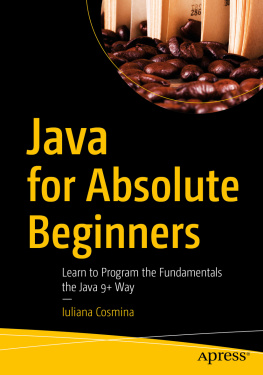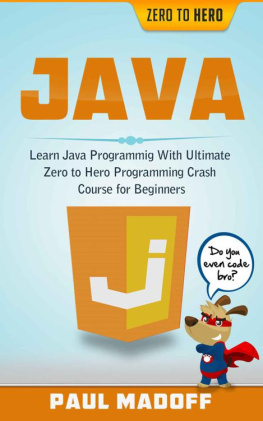John Smiley - Learn to program with Java
Here you can read online John Smiley - Learn to program with Java full text of the book (entire story) in english for free. Download pdf and epub, get meaning, cover and reviews about this ebook. year: 2001, publisher: Smiley Publishing, genre: Computer. Description of the work, (preface) as well as reviews are available. Best literature library LitArk.com created for fans of good reading and offers a wide selection of genres:
Romance novel
Science fiction
Adventure
Detective
Science
History
Home and family
Prose
Art
Politics
Computer
Non-fiction
Religion
Business
Children
Humor
Choose a favorite category and find really read worthwhile books. Enjoy immersion in the world of imagination, feel the emotions of the characters or learn something new for yourself, make an fascinating discovery.

- Book:Learn to program with Java
- Author:
- Publisher:Smiley Publishing
- Genre:
- Year:2001
- Rating:3 / 5
- Favourites:Add to favourites
- Your mark:
- 60
- 1
- 2
- 3
- 4
- 5
Learn to program with Java: summary, description and annotation
We offer to read an annotation, description, summary or preface (depends on what the author of the book "Learn to program with Java" wrote himself). If you haven't found the necessary information about the book — write in the comments, we will try to find it.
Learn to program with Java — read online for free the complete book (whole text) full work
Below is the text of the book, divided by pages. System saving the place of the last page read, allows you to conveniently read the book "Learn to program with Java" online for free, without having to search again every time where you left off. Put a bookmark, and you can go to the page where you finished reading at any time.
Font size:
Interval:
Bookmark:
Learn to
Program
with Java tm
John Smiley
Smiley Publishing
Philadelphia
Smiley Publishing
PO Box 57003
Philadelphia PA 19111
U.S.A.
smileypublishing@johnsmiley.com
Learn to Program with Java tm
ISBN: 978-1-61274-004-1
Learn to Program with Visual Basic 6
Learn to Program with Visual Basic 6 Examples
Learn to Program am with Visual Basic 6 Objects
Learn to Program with Visual Basic 6 Databases
Learn to Program with VB.Net 2002/2003
Learn to Program with VB.Net 2005 Express
Learn to Program with Java
Learn to Program with C#
Learn to Program with C++
Learn to Program with JavaScript
Copyright John Smiley and Associates
All Rights Reserved
Printed in the United States of America
10 9 8 7 6 5 4 3 2 1
This book is dedicated to my wife Linda
About the Author
John Smiley, a Microsoft Certified Professional (MCP) and Microsoft Certified Solutions Developer (MCSD) in Visual Basic, has been programming and teaching for more than 20 years. He is the President of John Smiley and Associates, a computer consulting firm serving clients both large and small in the Philadelphia Metropolitan area. John is an adjunct professor of Computer Science at Penn State University , Philadelphia University , and Holy Family College , and also teaches in a variety of Internet venues including SmartPlanet and ElementK.
On the writing front, John is the author of the immensely popular Learn to Program with Visual Basic 6 , along with Learn to Program with Visual Basic Examples, Learn to Program Databases with Visual Basic 6, Learn to Program Objects with Visual Basic 6, Learn to Program with Java, Learn to Program with VB.Net 2002/2003, Learn to Program with VB.Net 2005 Express, Learn to Program with C#, Learn to Program with C++ and Learn to Program with JavaScript..
Feel free to visit John's Web Site at
http:/ /www.johnsmiley.com
or contact him via email at johnsmiley@johnsmiley.com. He religiously answers all of his emails, although not necessarily instantaneously!
Contents
Contents
Acknowledgments
I want to thank first and foremost my wife Linda for her love and support.
This book is a reprint of a book originally published by Osborne/McGraw Hill. Osborne believed that the market for beginner books had dried up, and gave me the rights to publish my own book---this book is a partnership between me and Lulu press.
Having said that, I must thank those who still believe in the viability of my books.
Many thanks also go to the thousands of students I've taught over the years for your tireless dedication to learning the art and science of computer programming. Your great questions and demanding persistence in getting the most out of your learning experience truly inspired me, and has contributed greatly to my books. Many of you dragged yourself to class after a long hard day of work, or rose early on your Saturday day off to learn Visual Basic and the other programming languages I have taught. You have my greatest respect and admiration.
I also want to thank the many readers of my nine books who took the time to write or email me about the books. Most of the time, the correspondence is incredibly glowing---I truly appreciate hearing from each of you, and I want you to know that I read and respond to each email I receive.
I want to thank all the members of my family for their continued belief in and support of me over the years, in particular my mother, who continues to say several hundred novenas for the success of my books, and who has probably said just as many for this one I'm sure.
Finally, I want to acknowledge my father, who although not physically here to see this book, is surely flipping through the pages of it now. It's been over twenty five years since I last saw you---and your role in the writing of this and my others books can never be understated---you and mother have been a great inspiration and role model for me. I know that the God who made us all will someday permit us to be together again.
Organizations/Conventions Used in the Book
Each chapter of the book follows in a session in a make-believe college classroom. Read along and learn the material with the rest of the students.
Every chapter has example programs and practical exercises for you to complete. I encourage you to follow along with the example programs---and by all means complete the exercises in the book as well. If typing is not your strong suit, you can download both the completed examples and exercises via this link
http:/ /www.johnsmiley.com/main/ my books.htm
Care to take a quiz to test your knowledge? Follow this link and you can take a series of multiple choice quizzes drawn from the book
http:/ /www.johnsmiley.com/tester/login.asp
Finally, if the book isnt enough for you to get going with Java, consider joining me in an Internet-based Java class. My introductory classes are held several times throughout the year---and Ill be teaching these classes for as long as Im sojourning in this dimension. For more information, follow this link
http:/ /www.johnsmiley.com/main/training. htm
Chapter 1: Where Do I Begin?
"Where do I begin?" is a question I am frequently asked by my students, and this seems like a good question to tackle right at the beginning of this book. In this first chapter, we'll look at the development process of an actual working program through the eyes and ears of my university programming class and you will also be introduced to our 'class project'. By the end of the book, well have taken a real-life application through from the concept all the way to the finished product!
NOTE: Occasionally, my students get disillusioned when they hear that we wont be diving straight in and coding our application. However, when I remind them that programming is much the same as writing a report (or in other words, it is a two stage process of planning and then producing) they tend to settle down.
As part of answering the question, "Where do we begin?" this chapter looks at the Systems Development Life Cycle , which is a methodology that has been developed to ensure that systems are developed in a methodical, logical and step-by-step approach. We'll be looking at the Systems Development Life Cycle in quite a bit of detail, since the majority of this book will be spent in developing a real-world application. In this chapter we'll meet with a prospective client and conduct a preliminary interview with him. From that interview (and a subsequent one!) we'll develop a Requirements Statement , which provides details as to what the program should do. This Requirements Statement will form the basis of the application that we will develop throughout the rest of the book
NOTE: From this point on, you will follow me as I lead a group of my university students in an actual class on Java. If I do my job right, you will be a part of the class, learning along with them as we complete a 14-week course about programming in Java.
Many books on computer programming have the reader, perhaps as early as the first chapter, code a program which 'cutely' displays a message box that says 'Hello World'. Then the author will point to the fact that within the first few minutes of reading their book, the reader has already written a working program. I'm not so naive as to believe that writing such a program makes you a programmer. Therefore, we'll opt for a slower approach. Simple programs, although great for the ego, are not the programs that are found in the real world. Real-world programs are written to meet someone's needs. These needs are frequently complex and difficult to verbalize. In this book, you and I will embark on a journey together that will see us complete the prototyping stage of a real-world project. I believe that this is the best way to learn programming.
Next pageFont size:
Interval:
Bookmark:
Similar books «Learn to program with Java»
Look at similar books to Learn to program with Java. We have selected literature similar in name and meaning in the hope of providing readers with more options to find new, interesting, not yet read works.
Discussion, reviews of the book Learn to program with Java and just readers' own opinions. Leave your comments, write what you think about the work, its meaning or the main characters. Specify what exactly you liked and what you didn't like, and why you think so.





